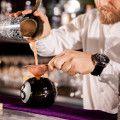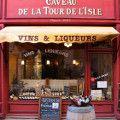A meal cooked at home is quite different from a meal produced by a professional chef in a restaurant. This also holds true for cocktails as well.
There is a world of difference between a cocktail made at home for your guests and a cocktail made by a professional mixologist.
There is a chasm of quality between home made cocktails and bar made cocktails largely because of the level of expertise and skills of the bar expert.
Crossing the Chasm of Quality
So how do we cross this chasm?
It is important to realize the essential elements that create the gap between an amateur and a professionally made cocktail.
Quality ingredients are mandatory but often lacking in the amateur’s bar.
Specific tools of the trade do make a real difference.
Knowledge and skill that the pro bar expert brings from study and experience are critical and take time to master.
Even the most talented amateurs are not professional bar superstars. In the same way that great cooks are not Michelin-Star Chefs.
Novice bar tenders can improve by focusing on the elements within their control.
Making cocktails is NOT….
Slapping together alcohols and ingredients while proclaiming your artistic bartending skills.
Decorating a plain cocktail glass with endless fruit, parasols, plastic mice, and any other adornment you can find.
Measuring ingredients by eye. Although a professional can do this, even they still measure meticulously to get it right.
- Mixing and pouring in inadequate space.
- Juggling bottles around haphazardly imitating Tom Cruise in the movie Cocktail.
- Streaming liquids from bottles to mixers to glass.
Making great cocktails IS….
Respecting the process by taking ingredients seriously.
Adorning the glass with simple, classic decorations that make a statement.
Measuring with precision. Just as carpenters measure twice and cut once, amateur cocktail makers should measure twice, pour once.
Ensuring ample space is available for both preparation and ingredient storage.
Handling and pouring a single bottle at a time. Leave the legend of bottle slinging to the movies.
Concentrating less on the show and more on the actual cocktail being created.
Remember that the objective is a happy guest, cocktail in hand, delighting at its delicious blend of ingredients. And a smooth process getting there.
Too often home made cocktails are substandard because of a lack of respect for the process. Rather than your guests enjoying your delicious creation you settle for guests simply holding the mixture you pulled together.
Respect the process, respect the ingredients, and the result will be much, much better.
Rimming the Glass
All of the ingredients used should be the best available. This includes not only the alcohols and mixes, but every additional ingredient used, including those to rim and adorn the glass.
Rimming is a classic technique of adornment and easily accomplished by using a rimming dish, or any small plate with a slight rim.
Hundreds of times I have been handed a Margarita rimmed with supermarket quality powdered salt that quite frankly spoiled the drink. Kosher salt or an upscale chef-grade flake sea salt is always the best option.

This photo has been taken from an excellent article about how to rim a glass like a pro, and is certainly worth a look.
I should mention here, that rimming half the glass gives the guest the option of drinking from the unsalted rim. While a very democratic idea, a fully rimmed glass is the standard.
Rimming with quality ingredients is certainly the way to go.
How crazy can rimming get?
How about a graham cracker rim?
Take a look at this wild Thanksgiving Martini called the Pumpkin Pie Martini. Truly a dessert in a glass deliciously made from only the best ingredients. Be certain to grate the nutmeg fresh.
Additional Ingredients
Olives are an often used cocktail ingredient. Unfortunately, 50% of the time olives are purchased based on cost instead of flavour and firmness. Buying for freshness, firmness, and taste makes a real difference.
Pitted olives are better for many reasons. Most obvious is that you don’t have to deal with the pit. A pitted olive also allows the liquids to enter the olive, making it deliciously flavourful.
Pitted olives are available already soaked in vermouth or the standard pitted green queen, both of which will elevate the cocktail to a new level.
Citrus peels are also a fabulous way to add flavor and adornment to cocktails. Achieving the best results requires an assortment of knives, peelers, and zesters and plenty of preparation space at the bar.

So what about that flaming orange trick?
Let me share with you three important things.
First, some kudos. This is one of the top showmanship tricks in the deep bag of mixology techniques that a professional bartender brings to the table. Customers clap. Customers laugh. And most importantly customers tip. And tip some more.
Second, the reason the orange peel is flamed is to enhance the flavour. Flaming the peel releases the essential oils of the orange into the drink. It also caramelizes the sugars in the oil and juice. It is very subtle and for me personally, a flamed peel is the qualitative autobahn to a great Sidecar.
Third, this burnt orange trick goes way, way back to the days of drinker, entertainer extraordinaire Dean Martin who asked Beverly Hills bartender Pepe Ruiz in the early 1970’s to make him something different. Pepe thought about it and came up with this uber-complicated cocktail that required a lot of glass preparation. He called it The Flame of Love.
Take a look at the recipe and story here.
Flame Of Love (recipe adapted from Robert Hess)
Ingredients
2 oz Vodka
Splash of fine sherry
Directions
Coat a chilled martini glass with sherry and pour out the excess.
Flame several orange peels into the glass (about 8 times).
Stir the vodka with ice, then strain into the glass.
Squeeze an orange peel over the drink and then rub it around the rim to coat it well.
Use matches to flame the fresh peel of an organic orange, to avoid wax and pesticides.
For the full technique, read this article by Serious Eats. It is cool, but don’t burn your fingers (or the house) when practicing.
Making Cocktails at Home
Successful in home cocktail-making requires being realistic about your skill level and using only the best ingredients.
A host can simplify cocktail preparation by making a small list of those achievable and sticking to it. Although I like a cocktail called a Shark’s Tooth, which was made by Trader Vic eons ago, I would never ask a host to make it for me because it is so complicated.
If you want to try a cocktail the way it should be made, call the best mixologist in the city and ask them to make it for you in the down time hours of the day. I will be calling Lauren Mote in Vancouver, arguably one of the best cocktail makers on the planet, for her take of The Flame of Love described earlier.
Which cocktails should you serve?
Honestly, if you are doing it yourself, make a list and stick to it.
Or, even better, invite a bartender to dinner and put them to work making the drinks. And or course, pay them for their work.
What are the best cocktails?
It really depends on where you live. I fondly remember a drink advisor article on the best cocktails (from 2008). It was hilarious, but perfectly lined up the most popular cocktails to serve.
One very smart thing to do is email all of your guests a Survey Monkey form asking them to choose from a list of several items. This is a time saving and fun way to ensure all of your guests are satisfied.
Today, there are numerous apps to choose from. Some fun, some serious.
Mixology – A free app that is a workhorse of information.
Inthespirit Easy Cocktails – A free app that is a drink + ingredient tool.
Liquor Cabinet – … An app that cost $0.99 USD but absolutely worth it. Use it to find out what drinks you can create based on your bar stock.
There are so many more to investigate, and the number is growing every day.
The Future of Cocktails
What does the future hold for unique cocktail ingredients and the acquired knowledge in the 21st century?
Consider the power of communication. Think about walking into a bar, taking a seat, and ordering a drink on your phone, perhaps by specifying the alcohol type.
For me, this would be Cointreau. Certainly better than the much cheaper, and harsher, triple sec, often used in a Sidecar.
The cocktail would be brought to your table, and you would use your phone to pay, or even prepay, including the tip.
Maybe if you prepay the drink will be less expensive?
Ah, the future is bright.
Cheers!






